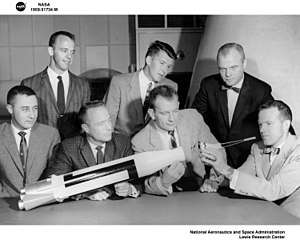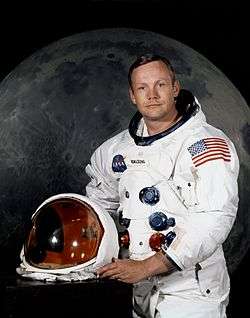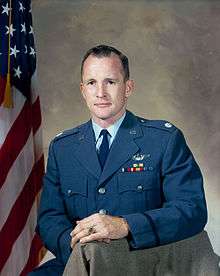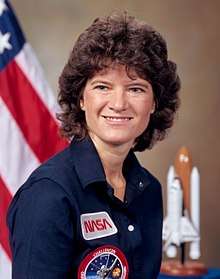United States Astronaut Hall of Fame

The United States Astronaut Hall of Fame, located inside the Kennedy Space Center Visitor Complex Heroes & Legends building, honors American astronauts and features the world's largest collection of their personal memorabilia, focusing on those astronauts who have been inducted into the Hall; as well as Sigma 7, the fifth manned Mercury spacecraft.
History

In the 1980s, the six then-surviving Mercury Seven astronauts conceived of establishing a place where US space travelers could be remembered and honored, along the lines of halls of fame for other fields.[1] The Mercury Seven Foundation and Astronaut Scholarship Foundation were formed and have a role in the current operations of the Hall of Fame. The foundation's first executive director was former Associated Press space reporter Howard Benedict.
.jpg)
The Astronaut Hall of Fame was opened on October 29, 1990, by the U.S. Space Camp Foundation, which was the first owner of the facility. It was located next to the Florida branch of Space Camp.[2]
The Hall of Fame closed for several months in 2002 when U.S. Space Camp Foundation's creditors foreclosed on the property due to low attendance and mounting debt.[3] That September, an auction was held and the property was purchased by Delaware North Park Services on behalf of NASA and the property was added to the Kennedy Space Center Visitor Complex. The Hall of Fame re-opened December 14, 2002.[4]
The original Hall of Fame which was located just west of the NASA Causeway closed to the public on November 2, 2015, in preparation for its relocation and re-launch at the Kennedy Space Center Visitor Complex 6 miles (9.7 km) to the east on Merritt Island. Outside of the building was a full-scale replica of Space Shuttle Inspiration where visitors can enter the inside and view.
That building was purchased at auction by visitor complex operator Delaware North and renamed the ATX Center and houses educational programs including Camp Kennedy Space Center and the Astronaut Training Experience.[5]
Inductees
Inductees into the Hall of Fame are selected by a blue ribbon committee of former NASA officials and flight controllers, historians, journalists, and other space authorities based on their accomplishments in space or their contributions to the advancement of space exploration.[6] Except for 2002, inductions have been held every year since 2001.


As its inaugural class in 1990, the Hall of Fame inducted the United States' original group of astronauts: the Mercury Seven. In addition to being the first American astronauts, they set several firsts in American spaceflight, both auspicious and tragic. Alan Shepard was the first American in space and later became one of the twelve people to walk on the Moon. John Glenn was the first American to orbit the Earth and after his induction went on, in 1998, to become the oldest man to fly in space, aged 77. Gus Grissom was the first American to fly in space twice and was the commander of the ill-fated Apollo 1, which resulted in the first astronaut deaths directly related to preparation for spaceflight.


Thirteen astronauts from the Gemini and Apollo programs were inducted in 1993. This class included the first and last humans to walk on the Moon, Neil Armstrong and Eugene Cernan; Ed White, the first American to walk in space (also killed in the Apollo 1 accident); Jim Lovell, commander of the famously near-tragic Apollo 13; and John Young, whose six flights included a moonwalk and command of the first Space Shuttle mission.
The third class was inducted in 1997 and consisted of the 24 additional Gemini, Apollo, and Skylab astronauts. Notable members of the class were Roger Chaffee, the third astronaut killed in the Apollo 1 fire and the only unflown astronaut in the Hall; Harrison Schmitt, the first scientist and next-to-last person to walk on the Moon; and Jack Swigert and Fred Haise, the Apollo 13 crewmembers not previously inducted.
Over two dozen astronauts from the Space Shuttle program have been inducted since 2001. Among these are Sally Ride, the first American woman in space; Story Musgrave, who flew six missions in the 1980s and 90s; and Francis Scobee, commander of the ill-fated final Challenger mission.[7]
The 2010 class consisted of Guion Bluford, Jr., Kenneth Bowersox, Frank Culbertson and Kathryn Thornton.[8] The 2011 inductees were Karol Bobko and Susan Helms.[9] The 2012 inductees were Franklin Chang-Diaz, Kevin Chilton and Charles Precourt.[10] Bonnie Dunbar, Curt Brown and Eileen Collins were inducted in 2013,[11] and Shannon Lucid and Jerry Ross comprised the 2014 class.[12]
In 2016, inductees included Brian Duffy and Scott E. Parazynski.
Ellen Ochoa and Michael Foale are announced as the 2017 class of the United States Astronaut Hall of Fame. [13]
Exhibits


The Hall of Heroes is composed of tributes to the inductees. Among the Hall of Fame's displays is Sigma 7, the Mercury spacecraft piloted by Wally Schirra which orbited the Earth six times in 1962. An Astronaut Adventure room includes simulators for use by children.
The spacesuit worn by Gus Grissom during his Mercury flight is on display and has been the subject of a dispute between NASA and Grissom's heirs and supporters since 2002. The spacesuit, along with other Grissom artifacts, were loaned to the original owners of the Hall of Fame by the Grissom family when it opened. After the Hall of Fame went into bankruptcy and was taken over by a NASA contractor in 2002, the family requested that all their items be returned.[14] All of the items were returned to Grissom's family except the spacesuit, because both NASA and the Grissoms claim ownership of it.[15] NASA claims Grissom checked out the spacesuit for a show and tell at his son's school, and then never returned it, while the Grissoms claim Gus rescued the spacesuit from a scrap heap.[16]
Gallery
 Alan Shepard's Apollo 14 lunar space suit
Alan Shepard's Apollo 14 lunar space suit Replica of Apollo 15 Genesis Rock
Replica of Apollo 15 Genesis Rock

- Replica of the Space Shuttle at the entry of the former United States Astronaut Hall of Fame
See also
References
- ↑ U.S. Astronaut Hall of Fame at Kennedy Space Center Visitor Complex Archived 2009-05-19 at the Wayback Machine., retrieved 2007-08-23
- ↑ Jay Clarke (1990-10-30). "Mercury Museum -- Hall Of Fame Honors 7 Who Blazed A Trail In Space". The Seattle Times. Retrieved 2007-05-27.
- ↑ Corey Schubert (2002-08-07). "Space Camp Florida Faces Foreclosure, Low Attendance Partly to Blame". Florida Today. Archived from the original on 2008-06-18. Retrieved 2007-05-27.
- ↑ "Astronaut Hall of Fame Reopens to Public Saturday, Dec. 14 As Newest Attraction at Kennedy Space Center Visitor Complex". Kennedy Space Center Visitor Complex. 2002-12-14. Retrieved 2007-05-27.
- ↑ "U.S. Astronaut Hall of Fame closing soon for relocation". Florida Today. Retrieved 2018-07-28.
- ↑ "Boeing Executive Inducted Into Astronaut Hall of Fame". The Boeing Company. 2004-05-04. Archived from the original on June 13, 2008. Retrieved 2007-05-27.
- ↑ U.S. Astronaut Hall of Fame at KSC Visitor Complex - Astronaut Scholarship Foundation Archived 2009-05-19 at the Wayback Machine., United States Astronaut Hall of Fame, retrieved 2009-05-04
- ↑ "2010 U.S. Astronaut Hall of Fame Induction Gala". Astronaut Scholarship Foundation. Archived from the original on May 1, 2010. Retrieved May 10, 2010.
- ↑ "2011 U.S. Astronaut Hall of Fame Induction". Astronautscholarship.org. Archived from the original on 17 February 2011. Retrieved 10 August 2017.
- ↑ "Astronaut Hall of Fame's new space shuttle inductees humbled by heroes' welcome - collectSPACE". collectSPACE.com. Retrieved 10 August 2017.
- ↑ "Astronaut Hall of Fame adds space shuttle vets Brown, Collins and Dunbar" April 21, 2013 CollectSpace.com
- ↑ "Astronaut Hall of Fame inducts two record-setting space shuttle fliers" May 4, 2013 CollectSpace.com
- ↑ "U.S. Astronaut Hall of Fame Induction Ceremony & Gala". Retrieved February 22, 2017.
- ↑ John Kelly (2002-11-20). "Gus Grissom's Family, NASA Fight Over Spacesuit". Florida Today. Retrieved 2007-05-27.
- ↑ "NASA, Astronaut's Family Fight Over a Spacesuit". Washington Post. 2002-11-30. Retrieved 2007-05-04.
- ↑ Christopher Lee (2005-08-24). "Grissom Spacesuit in Tug of War". Washington Post. Retrieved 2007-05-27.
External links
| Wikimedia Commons has media related to Astronaut Hall of Fame. |
- U.S. Astronaut Hall of Fame at the Kennedy Space Center
- Astronaut Scholarship Foundation
- Review of exhibits at RoadsideAmerica.com
- Worldspaceflight.com list of inductees and dates of induction
Coordinates: 28°31′22″N 80°40′59″W / 28.522840°N 80.683022°W